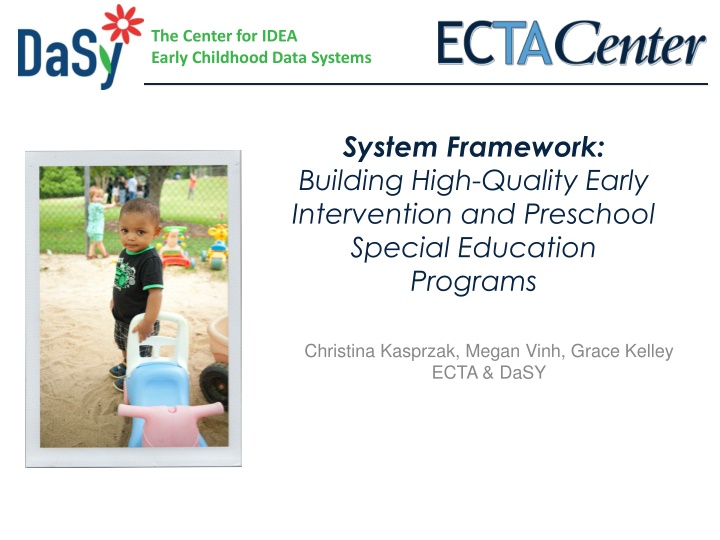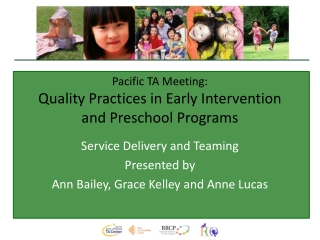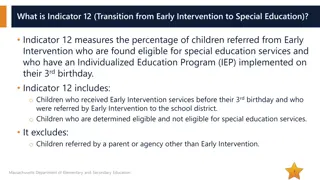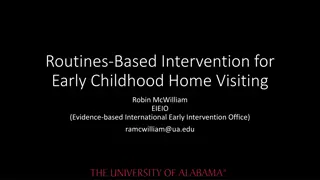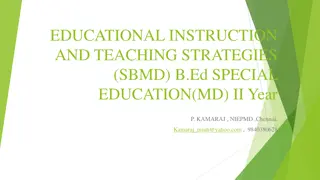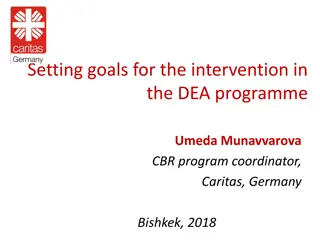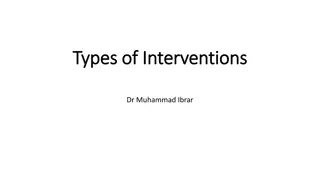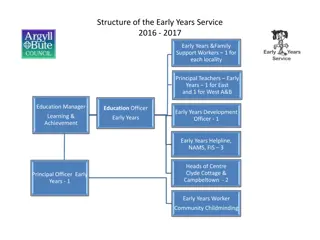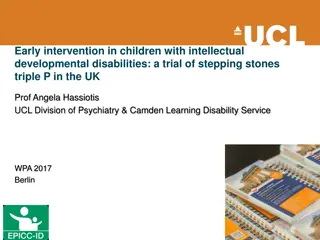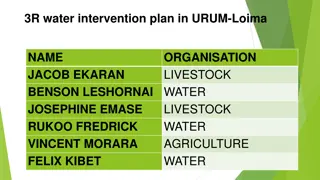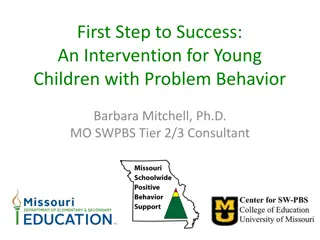Building High-Quality Early Intervention Programs Framework
A comprehensive framework developed by Christina Kasprzak, Megan Vinh, and Grace Kelley from ECTA & DaSY to guide states in evaluating and improving their early intervention programs. It provides a common understanding of high-quality systems, aligns with effective practices, and supports states in enhancing their systems for better outcomes for children and families.
Download Presentation

Please find below an Image/Link to download the presentation.
The content on the website is provided AS IS for your information and personal use only. It may not be sold, licensed, or shared on other websites without obtaining consent from the author.If you encounter any issues during the download, it is possible that the publisher has removed the file from their server.
You are allowed to download the files provided on this website for personal or commercial use, subject to the condition that they are used lawfully. All files are the property of their respective owners.
The content on the website is provided AS IS for your information and personal use only. It may not be sold, licensed, or shared on other websites without obtaining consent from the author.
E N D
Presentation Transcript
The Center for IDEA Early Childhood Data Systems System Framework: Building High-Quality Early Intervention and Preschool Special Education Programs Christina Kasprzak, Megan Vinh, Grace Kelley ECTA & DaSY
The Center for IDEA Early Childhood Data Systems What we will cover: 1. Why we need a System Framework 2. Purpose and Audience 3. Development Process and Partners 4. Content and Use of the Framework and Self- Assessment?
The Center for IDEA Early Childhood Data Systems
The Center for IDEA Early Childhood Data Systems Why do we need a System Framework? Provides common definition and understanding of high quality systems Provides clear components and elements of a high quality system Aligns with and supports implementation of effective practices (RPs; EBPs) Provides states with a framework for evaluating and improving their system By completing the self assessment it provides focus for program planning
The Center for IDEA Early Childhood Data Systems System Framework: Purpose and Audience Purpose: to guide states in evaluating their current Part C/619 system, identifying areas for improvement, and providing direction on how to develop a more effective, efficient Part C and Section 619 system that requires, supports, and encourages implementation of effective practices. Audience: the key audience is state Part C and state Section 619 coordinators and staff, with acknowledgement that other key staff and leadership in a state will need to be involved.
The Center for IDEA Early Childhood Data Systems Framework Structure
The Center for IDEA Early Childhood Data Systems What does a state need to put into place to support implementation of effective practices? Governance Result Quality Standards Finance Implementation of Effective Practices Good outcomes for children with disabilities and their families Building High-Quality Systems Accountability & Quality Improvement Personnel / Workforce Data System ectacenter.org/sysframe
The Center for IDEA Early Childhood Data Systems DEC Recommended Practices L12. Leaders collaborate with stakeholders to collect and use data for program management and continuous program improvement and to examine the effectiveness of services and supports in improving child and family outcomes. L9. Leaders develop and implement an evidence-based professional development system or approach that provides practitioners a variety of supports to ensure they have the knowledge and skills needed to implement the DEC Recommended Practices
The Center for IDEA Early Childhood Data Systems Components/Subcomponents of the Framework Governance Finance Vision, Mission and/or Purpose Legal Foundations Administrative Structures Leadership and Performance Management Finance Planning Process/ Forecasting Fiscal Data Procurement Resource Allocation, Use of Funds and Disbursement Monitoring and Accountability of Funds and Resources
The Center for IDEA Early Childhood Data Systems Components/Subcomponents cont d Accountability & Quality Improvement Planning for Accountability and Improvement Collecting and Analyzing Performance Data Using Results for Continuous Improvement Quality Standards Child Level Standards Program Standards
The Center for IDEA Early Childhood Data Systems Components/Subcomponents cont d Personnel/Workforce Data Systems Leadership, Coordination and Sustainability State Personnel Standards Pre-service Personnel Development In-service Personnel Development Recruitment and Retention Evaluation Purpose and Vision Data Governance and Management Stakeholder Engagement System Design/Development Data Use Sustainability
The Center for IDEA Early Childhood Data Systems Cross cutting themes Engaging stakeholders, including families Establishing/revising policies Promoting collaboration Using data for improvement Communicating effectively Family Leadership & Support Coordinating/Integrating across early childhood
The Center for IDEA Early Childhood Data Systems Additional Pieces 1. 2. Self-assessment to evaluate state systems Glossary of terms nearly complete; aligned with other glossaries Resources for planning and improvement under development; developed over time TA supports from ECTA on: conducting self-assessment planning for improvement implementing improvement strategies 3. 4.
The Center for IDEA Early Childhood Data Systems Corresponding Self-Assessment 1. Provides states a current status snap shot to help them prioritize improvement efforts 2. Quantitative self-assessment score provides states ability to measure progress over multiple points in time. 3. Encourages state participants to engage in rich conversations about the system. Shared purpose and structure with DaSy framework (data system component)
The Center for IDEA Early Childhood Data Systems Element Rating Scale Element of Quality Rating Scale No - element not in place and not planning to work on it at this time 1 No No - element not in place but planning to work on it or getting started 2 No, planning 3 Yes, partially Yes - element partially implemented 4 Yes, fully Yes - element fully implemented
The Center for IDEA Early Childhood Data Systems Quality Indicator Rating Scale Quality Indicator Rating Scale 1 None of the elements are yet planned or in place 2 Most of the elements are not yet planned or in place 3 Some elements are in place, a few may be fully implemented 4 At least half of the elements are in place; a few may be fully implemented 5 At least half of the elements are in place; some are fully implemented 6 At least half of the elements are fully implemented, the rest are partially implemented 7 All elements are fully implemented
The Center for IDEA Early Childhood Data Systems How are States Using the System Framework and Self-Assessment?
The Center for IDEA Early Childhood Data Systems Suggested Process Select area of focus (component, subcomponent) Identify the stakeholders for the self-assessment process Complete the self-assessment Review results to determine priorities Develop improvement plan Implement improvement plan Lather, rinses, repeat (in future) to identify progress and new areas for improvement
The Center for IDEA Early Childhood Data Systems State Examples
The Center for IDEA Early Childhood Data Systems Idaho Idaho completed the Self-Assessment for both their ECSE and K-12 special education state systems. The state is using the information gathered from the Self-Assessment to: develop an action plan for both the preschool and K-12 special education programs; and work with districts to use the Self-Assessment to self-audit and monitor progress toward implementing each of the system components at the local level.
The Center for IDEA Early Childhood Data Systems In Your State Are there efforts to align work across EI, ECSE, and K- 12? Are there efforts to align work across EI, ECSE, Head Start, Child Care, PreK?
The Center for IDEA Early Childhood Data Systems Activity: Leadership and Performance Management Quality Indicator GV7: Leaders use written priorities with corresponding strategic plan(s) and evaluation to drive ongoing system improvement. Discuss the quality indicator and elements of quality. How might engaging in the self-assessment process and identifying areas for improvement support a state s efforts to align work?
The Center for IDEA Early Childhood Data Systems Delaware This work has had powerful effects for Delaware: The results of the state cross sector system framework workgroup brought a new focus on the need for well trained professional staff in all of the inclusive environments that enroll children with disabilities. The work truly highlighted the importance of each of the system framework components for all early childhood - not just ECSE.
The Center for IDEA Early Childhood Data Systems Personnel/Workforce: Preservice Quality Indicator PN5: Institution of higher education (IHE) programs and curricula across disciplines are aligned with both national professional organization personnel standards and state personnel standards. Quality Indicator PN6: Institution of higher education programs and curricula address early childhood development and discipline-specific pedagogy.
The Center for IDEA Early Childhood Data Systems Personnel/Workforce: Inservice Quality Indicator PN7: A statewide system for inservice personnel development and technical assistance is in place for personnel across disciplines. Quality Indicator PN8: A statewide system for inservice personnel development and technical assistance is aligned and coordinated with higher education program and curricula across disciplines.
The Center for IDEA Early Childhood Data Systems Activity: Pre-Service and In-Service Choose one Quality Indictor to discuss at your table. Review the indicators and related elements. Which quality indicators are strengths in your state system? Which need the most improvement?
The Center for IDEA Early Childhood Data Systems Subcomponents of the DaSy Framework
The Center for IDEA Early Childhood Data Systems Colorado The Framework helped CO to: Integrate data between EI and ECSE; Improve data quality; Improve use of data at the state and local level; and Link transition data between EI and ECSE.
The Center for IDEA Early Childhood Data Systems DaSy Framework Addresses Three Major Uses of Data Accountability Federal and state reporting Program Improvement Identifying strengths and weaknesses, improving results Program Operations Day-to-day management and operation of program activities
The Center for IDEA Early Childhood Data Systems Data: Data Use Section 1: Planning for Data Use Quality Indicator DU1: Part C/619 state staff plan for data analysis, product development, and dissemination to address the needs of the state agency and other users.
The Center for IDEA Early Childhood Data Systems Data: Data Use Section 2: Analyzing and Disseminating for Use Quality Indicator DU2: Part C/619 state staff or representatives conduct data analysis activities and implement procedures to ensure the integrity of the data. Quality Indicator DU3: Part C/619 state and local staff or representatives prepare data products to promote understanding of the data and inform decision-making. Quality Indicator DU4: Part C/619 state and local staff or their representatives disseminate data products to users to meet their needs..
The Center for IDEA Early Childhood Data Systems Section 3: Using Data and Promoting Capacity for Data Use Quality Indicator DU5: Part C/619 state and local staff use data to inform decisions. Quality Indicator DU6: Part C/619 state staff or representatives support the use of data at state and local levels
The Center for IDEA Early Childhood Data Systems Activity: Data Use Review the indicators and the elements Which elements are strongest in your program? How do you know they are a strength for your program? What would your stakeholders say ?
The Center for IDEA Early Childhood Data Systems Discussion How might the System Framework as a resource/tool support these particular DEC RPs? L6. Leaders establish partnerships across levels (state to local) and with their counterparts in other systems and agencies to create coordinated and inclusive systems of services and supports L3. Leaders develop and implement policies, structures, and practices that promote shared decision making with practitioners and families.
The Center for IDEA Early Childhood Data Systems Discussion L12. Leaders collaborate with stakeholders to collect and use data for program management and continuous program improvement and to examine the effectiveness of services and supports in improving child and family outcomes. L9. . Leaders develop and implement an evidence-based professional development system or approach that provides practitioners a variety of supports to ensure they have the knowledge and skills needed to implement the DEC Recommended Practices
The Center for IDEA Early Childhood Data Systems The framework and materials are available on the ECTA website ... Resources and self- assessment materials are under development ectacenter.org/sysframe
